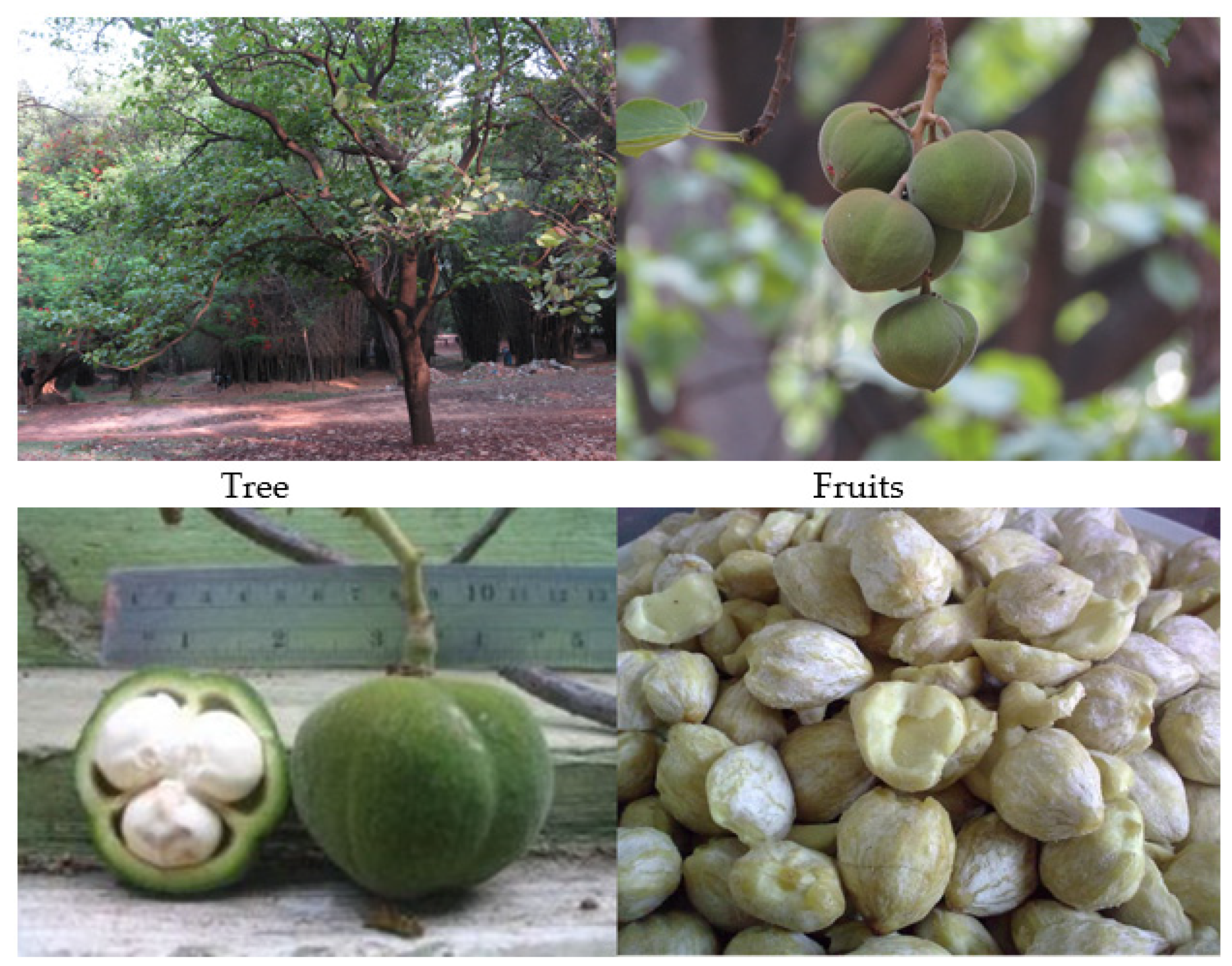Biodiesel Production from Reutealis trisperma Oil Using Conventional and Ultrasonication through Esterification and Transesterification
Abstract
1. Introduction
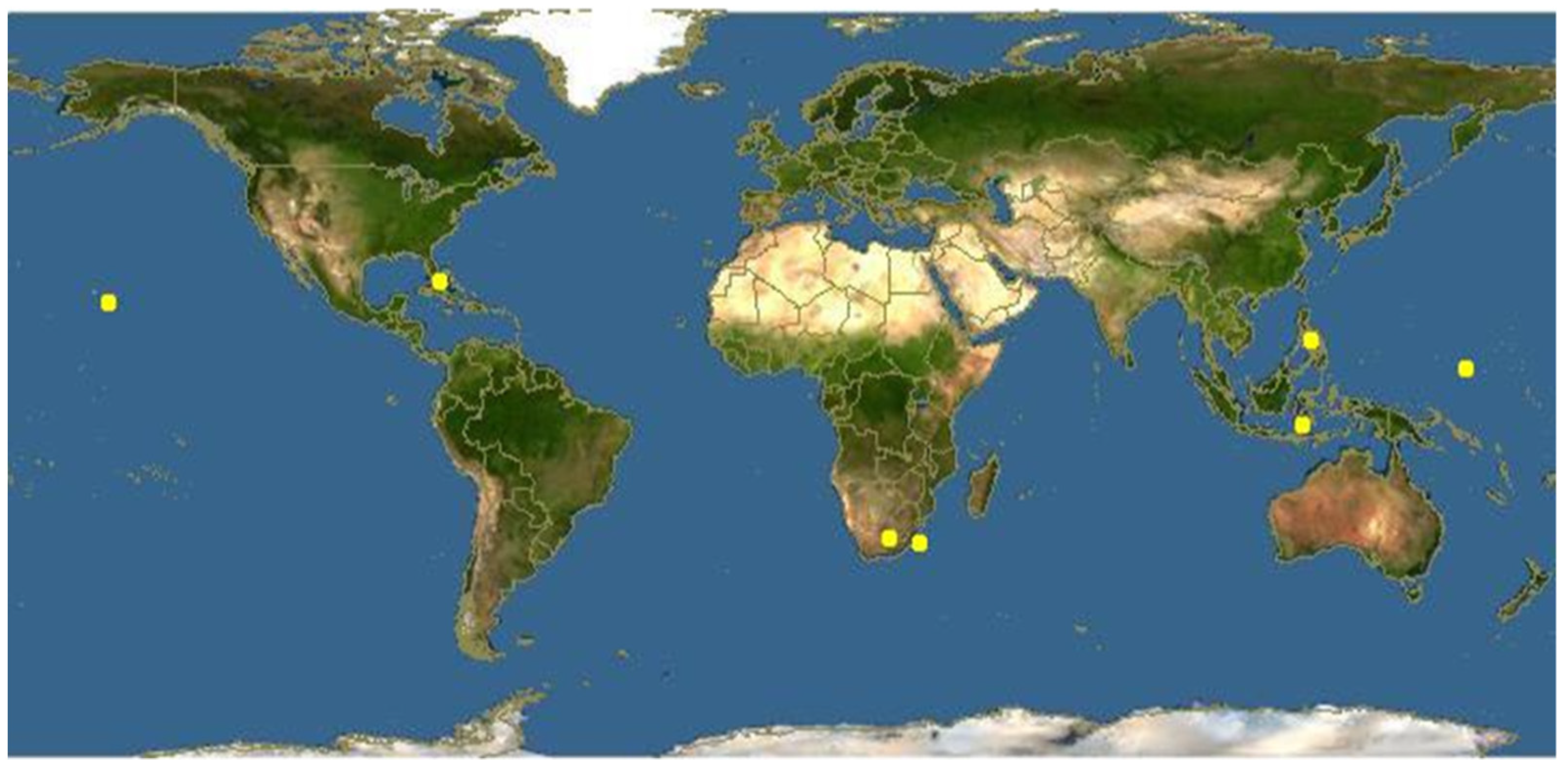
2. Materials and Methods
2.1. Materials and Apparatus
2.2. Degumming Process
2.3. Esterification Process
2.4. Transesterification Process
2.5. Characterization Fuel Properties
3. Results and Discussion
3.1. Properties of Crude Reutealis trisperma Oil
3.2. Fourier Transform Infrared Spectrum of the Reutealis trisperma Biodiesel
3.3. Physicochemical Properties of Reutealis trisperma Biodiesel Compare to Other Biodiesels
3.4. Effect of Esterification Process to Acid Value vs. Time
3.5. Effect of Transesterification Process on Acid Value vs. Time
3.6. Effect of Transesterification Process to Viscosity vs. Time
3.7. Effect of the Transesterification Process to Yield vs. Time
4. Conclusions
Author Contributions
Funding
Institutional Review Board Statement
Informed Consent Statement
Data Availability Statement
Acknowledgments
Conflicts of Interest
References
- Chong, C.T.; Mong, G.R.; Ng, J.-H.; Chong, W.W.F.; Ani, F.N.; Lam, S.S.; Ong, H.C. Pyrolysis characteristics and kinetic studies of horse manure using thermogravimetric analysis. Energy Convers. Manag. 2019, 180, 1260–1267. [Google Scholar] [CrossRef]
- Chia, S.R.; Ong, H.C.; Chew, K.W.; Show, P.L.; Phang, S.-M.; Ling, T.C.; Nagarajan, D.; Lee, D.-J.; Chang, J.-S. Sustainable approaches for algae utilisation in bioenergy production. Renew. Energy 2018, 129, 838–852. [Google Scholar] [CrossRef]
- Amini, Z.; Ilham, Z.; Ong, H.C.; Mazaheri, H.; Chen, W.-H. State of the art and prospective of lipase-catalyzed transesterification reaction for biodiesel production. Energy Convers. Manag. 2017, 141, 339–353. [Google Scholar] [CrossRef]
- Mahlia, T.; Syazmi, Z.; Mofijur, M.; Abas, A.P.; Bilad, M.; Ong, H.C.; Silitonga, A. Patent landscape review on biodiesel production: Technology updates. Renew. Sustain. Energy Rev. 2020, 118, 109526. [Google Scholar] [CrossRef]
- Ong, H.C.; Masjuki, H.; Mahlia, T.; Silitonga, A.; Chong, W.; Yusaf, T. Engine performance and emissions using Jatropha curcas, Ceiba pentandra and Calophyllum inophyllum biodiesel in a CI diesel engine. Energy 2014, 69, 427–445. [Google Scholar] [CrossRef]
- Ong, H.C.; Milano, J.; Silitonga, A.S.; Hassan, M.H.; Shamsuddin, A.H.; Wang, C.-T.; Mahlia, T.M.I.; Siswantoro, J.; Kusumo, F.; Sutrisno, J. Biodiesel production from Calophyllum inophyllum-Ceiba pentandra oil mixture: Optimization and characterization. J. Clean. Prod. 2019, 219, 183–198. [Google Scholar] [CrossRef]
- Silitonga, A.; Shamsuddin, A.; Mahlia, T.; Milano, J.; Kusumo, F.; Siswantoro, J.; Dharma, S.; Sebayang, A.; Masjuki, H.; Ong, H.C. Biodiesel synthesis from Ceiba pentandra oil by microwave irradiation-assisted transesterification: ELM modeling and optimization. Renew. Energy 2020, 146, 1278–1291. [Google Scholar] [CrossRef]
- Marri, V.B.; Kotha, M.M.; Gaddale, A.P.R.; Babu, M.V.; Murthy, K.M.; Rao, G.A.P. Production process optimisation of Sterculia foetida methyl esters (biodiesel) using response surface methodology. Int. J. Ambient. Energy 2020, 1–10. [Google Scholar] [CrossRef]
- Ashok, B.; Nanthagopal, K.; Darla, S.; Chyuan, O.H.; Ramesh, A.; Jacob, A.; Sahil, G.; Thiyagarajan, S.; Geo, V.E. Comparative assessment of hexanol and decanol as oxygenated additives with calophyllum inophyllum biodiesel. Energy 2019, 173, 494–510. [Google Scholar] [CrossRef]
- Silitonga, A.; Masjuki, H.; Mahlia, T.; Ong, H.; Chong, W.; Boosroh, M. Overview properties of biodiesel diesel blends from edible and non-edible feedstock. Renew. Sustain. Energy Rev. 2013, 22, 346–360. [Google Scholar] [CrossRef]
- Mallah, T.A.; Sahito, A.R. Optimization of castor and neem biodiesel blends and development of empirical models to predicts its characteristics. Fuel 2020, 262, 116341. [Google Scholar] [CrossRef]
- Nain, P.; Jaiswal, S.K.; Prakash, N.T.; Prakash, R.; Gupta, S.K. Influence of acyl acceptor blends on the ester yield and fuel properties of biodiesel generated by whole-cell catalysis of cottonseed oil. Fuel 2020, 259, 116258. [Google Scholar] [CrossRef]
- Dwivedi, G.; Jain, S.; Sharma, M.P. Diesel engine performance and emission analysis using biodiesel from various oil sources—Review. J. Mater. Environ. Sci. 2013, 4, 434–447. [Google Scholar]
- Singh, S.; Singh, D. Biodiesel production through the use of different sources and characterization of oils and their esters as the substitute of diesel: A review. Renew. Sustain. Energy Rev. 2010, 14, 200–216. [Google Scholar] [CrossRef]
- Leung, D.Y. Development of a Clean Biodiesel Fuel in Hong Kong Using Recycled Oil. Water Air Soil Pollut. 2001, 130, 277–282. [Google Scholar] [CrossRef]
- Mushrush, G.W.; Wynne, J.H.; Willauer, H.D.; Lloyd, C.T.; Hughes, J.M.; Beal, E.J. Recycled Soybean Cooking Oils As Blending Stocks for Diesel Fuels. Ind. Eng. Chem. Res. 2004, 43, 4944–4946. [Google Scholar] [CrossRef]
- Kumar, M.S.; Jaikumar, M. A comprehensive study on performance, emission and combustion behavior of a compression ignition engine fuelled with WCO (waste cooking oil) emulsion as fuel. J. Energy Inst. 2014, 87, 263–271. [Google Scholar] [CrossRef]
- López, I.; Pinzi, S.; Leiva-Candia, D.; Dorado, M. Multiple response optimization to reduce exhaust emissions and fuel consumption of a diesel engine fueled with olive pomace oil methyl ester/diesel fuel blends. Energy 2016, 117, 398–404. [Google Scholar] [CrossRef]
- de Almeida, V.F.; García-Moreno, P.J.; Guadix, A.; Guadix, E.M. Biodiesel production from mixtures of waste fish oil, palm oil and waste frying oil: Optimization of fuel properties. Fuel Process. Technol. 2015, 133, 152–160. [Google Scholar] [CrossRef]
- Sanli, H.; Canakci, M.; Alptekin, E.; Turkcan, A.; Ozsezen, A. Effects of waste frying oil based methyl and ethyl ester biodiesel fuels on the performance, combustion and emission characteristics of a DI diesel engine. Fuel 2015, 159, 179–187. [Google Scholar] [CrossRef]
- Zaher, F.A.; Megahed, O.A.; El Kinawy, O.S. Utilization of used frying oil as diesel engine fuel. Energy Sources 2003, 25, 819–826. [Google Scholar] [CrossRef]
- Silitonga, A.; Masjuki, H.; Ong, H.C.; Sebayang, A.; Dharma, S.; Kusumo, F.; Siswantoro, J.; Milano, J.; Daud, K.; Mahlia, T.; et al. Evaluation of the engine performance and exhaust emissions of biodiesel-bioethanol-diesel blends using kernel-based extreme learning machine. Energy 2018, 159, 1075–1087. [Google Scholar] [CrossRef]
- Ashok, B.; Raj, R.T.K.; Nanthagopal, K.; Tapaswi, A.; Jindal, A.; Subbish, S.H. Animal fat methyl ester as a fuel substitute for DI compression ignition engine. Int. J. Thermodyn. 2016, 19, 206–212. [Google Scholar]
- Ramos, Á.; García-Contreras, R.; Armas, O. Performance, combustion timing and emissions from a light duty vehicle at different altitudes fueled with animal fat biodiesel, GTL and diesel fuels. Appl. Energy 2016, 182, 507–517. [Google Scholar] [CrossRef]
- Teixeira, L.S.; Couto, M.B.; Souza, G.S.; Filho, M.A.; Assis, J.C.; Guimarães, P.R.; Pontes, L.A.; Almeida, S.Q.; Teixeira, J.S. Characterization of beef tallow biodiesel and their mixtures with soybean biodiesel and mineral diesel fuel. Biomass Bioenergy 2010, 34, 438–441. [Google Scholar] [CrossRef]
- Dhanasekaran, R.; Krishnamoorthy, V.; Rana, D.; Saravanan, S.; Nagendran, A.; Kumar, B.R. A sustainable and eco-friendly fueling approach for direct-injection diesel engines using restaurant yellow grease and n-pentanol in blends with diesel fuel. Fuel 2017, 193, 419–431. [Google Scholar] [CrossRef]
- Hanafi, S.A.; Elmelawy, M.S.; Shalaby, N.H.; El-Syed, H.A.; Eshaq, G.; Mostafa, M.S. Hydrocracking of waste chicken fat as a cost effective feedstock for renewable fuel production: A kinetic study. Egypt. J. Pet. 2016, 25, 531–537. [Google Scholar] [CrossRef]
- Yahyaee, R.; Ghobadian, B.; Najafi, G. Waste fish oil biodiesel as a source of renewable fuel in Iran. Renew. Sustain. Energy Rev. 2013, 17, 312–319. [Google Scholar] [CrossRef]
- Goh, B.H.H.; Ong, H.C.; Cheah, M.Y.; Chen, W.-H.; Yu, K.L.; Mahlia, T.M.I. Sustainability of direct biodiesel synthesis from microalgae biomass: A critical review. Renew. Sustain. Energy Rev. 2019, 107, 59–74. [Google Scholar] [CrossRef]
- Hena, S.; Fatimah, S.; Tabassum, S. Cultivation of algae consortium in a dairy farm wastewater for biodiesel production. Water Resour. Ind. 2015, 10, 1–14. [Google Scholar] [CrossRef]
- Calixto, C.D.; Santana, J.K.D.S.; Tibúrcio, V.P.; Pontes, L.D.F.B.L.D.; Sassi, C.F.D.C.; da Conceição, M.M.; Sassi, R. Productivity and fuel quality parameters of lipids obtained from 12 species of microalgae from the northeastern region of Brazil. Renew. Energy 2018, 115, 1144–1152. [Google Scholar] [CrossRef]
- Davis, R.; Aden, A.; Pienkos, P.T. Techno-economic analysis of autotrophic microalgae for fuel production. Appl. Energy 2011, 88, 3524–3531. [Google Scholar] [CrossRef]
- Karthikeyan, S.; Prathima, A. Microalgae biofuel with CeO2 nano additives as an eco-friendly fuel for CI engine. Energy Sources Part A Recover. Util. Environ. Eff. 2017, 39, 1332–1338. [Google Scholar] [CrossRef]
- Makareviciene, V.; Gumbyte, M.; Skorupskaite, V.; Sendzikiene, E. Biodiesel fuel production by enzymatic microalgae oil transesterification with ethanol. J. Renew. Sustain. Energy 2017, 9, 23101. [Google Scholar] [CrossRef]
- Mason, I.; Page, S.; Williamson, A. A 100% renewable electricity generation system for New Zealand utilising hydro, wind, geothermal and biomass resources. Energy Policy 2010, 38, 3973–3984. [Google Scholar] [CrossRef]
- Lee, X.J.; Ong, H.C.; Gan, Y.Y.; Chen, W.-H.; Mahlia, T.M.I. State of art review on conventional and advanced pyrolysis of macroalgae and microalgae for biochar, bio-oil and bio-syngas production. Energy Convers. Manag. 2020, 210, 112707. [Google Scholar] [CrossRef]
- Silitonga, A.; Mahlia, T.; Kusumo, F.; Dharma, S.; Sebayang, A.; Sembiring, R.; Shamsuddin, A. Intensification of Reutealis trisperma biodiesel production using infrared radiation: Simulation, optimisation and validation. Renew. Energy 2019, 133, 520–527. [Google Scholar] [CrossRef]
- Kumar, K.R.; Channarayappa; Chandrika, K.; Prasanna, K.T.; Gowda, B. Biodiesel production and characterization from non-edible oil tree species Aleurites trisperma Blanco. Biomass Convers. Biorefinery 2015, 5, 287–294. [Google Scholar] [CrossRef]
- Wikipedia, Reutealis Trisperma. 2016. Available online: https://en.wikipedia.org/wiki/Reutealis. (accessed on 13 April 2016).
- Sunan-drajat.blogspot.my, Kemiri Sunan. 2016. Available online: http://sunan-drajat.blogspot.my/ (accessed on 13 April 2016).
- Takase, M.; Feng, W.; Wang, W.; Gu, X.; Zhu, Y.; Li, T.; Yang, L.; Wu, X. Silybum marianum oil as a new potential non-edible feedstock for biodiesel: A comparison of its production using conventional and ultrasonic assisted method. Fuel Process. Technol. 2014, 123, 19–26. [Google Scholar] [CrossRef]
- Tan, S.X.; Lim, S.; Ong, H.C.; Pang, Y.L. State of the art review on development of ultrasound-assisted catalytic transesterification process for biodiesel production. Fuel 2019, 235, 886–907. [Google Scholar] [CrossRef]
- Aghbashlo, M.; Tabatabaei, M.; Amid, S.; Hosseinzadeh-Bandbafha, H.; Khoshnevisan, B.; Kianian, G. Life cycle assessment analysis of an ultrasound-assisted system converting waste cooking oil into biodiesel. Renew. Energy 2020, 151, 1352–1364. [Google Scholar] [CrossRef]
- Ambat, I.; Srivastava, V.; Sillanpää, M. Recent advancement in biodiesel production methodologies using various feedstock: A review. Renew. Sustain. Energy Rev. 2018, 90, 356–369. [Google Scholar] [CrossRef]
- Encinar, J.; González, J.F.G.; Pardal, A. Transesterification of castor oil under ultrasonic irradiation conditions. Preliminary results. Fuel Process. Technol. 2012, 103, 9–15. [Google Scholar] [CrossRef]
- Andrade-Tacca, C.A.; Chang, C.-C.; Chen, Y.-H.; Manh, D.-V.; Chang, C.-Y. Esterification of jatropha oil by sequential ultrasonic irradiation with auto-induced temperature rise and dosing of methanol and sulfuric acid catalyst. J. Taiwan Inst. Chem. Eng. 2014, 45, 1523–1531. [Google Scholar] [CrossRef]
- Chen, G.; Shan, R.; Shi, J.; Yan, B. Ultrasonic-assisted production of biodiesel from transesterification of palm oil over ostrich eggshell-derived CaO catalysts. Bioresour. Technol. 2014, 171, 428–432. [Google Scholar] [CrossRef]
- Georgogianni, K.G.; Kontominas, M.G.; Tegou, E.; Avlonitis, D.; Gergis, V. Biodiesel Production: Reaction and Process Parameters of Alkali-Catalyzed Transesterification of Waste Frying Oils. Energy Fuels 2007, 21, 3023–3027. [Google Scholar] [CrossRef]
- T.p. Corporation, Reutealis Trisperma 2016. Available online: http://www.discoverlife.org/mp/20m?map=Reutealis+trisperma (accessed on 23 February 2018).
- Holilah, H.; Prasetyoko, D.; Oetami, T.P.; Santosa, E.B.; Zein, Y.M.; Bahruji, H.; Fansuri, H.; Ediati, R.; Juwari, J. The potential of Reutealis trisperma seed as a new non-edible source for biodiesel production. Biomass Convers. Biorefinery 2015, 5, 347–353. [Google Scholar] [CrossRef]
- Ge, J.C.; Kim, H.Y.; Yoon, S.K.; Choi, N.J. Reducing volatile organic compound emissions from diesel engines using canola oil biodiesel fuel and blends. Fuel 2018, 218, 266–274. [Google Scholar] [CrossRef]
- Ge, J.C.; Kim, H.Y.; Yoon, S.K.; Choi, N.J. Optimization of palm oil biodiesel blends and engine operating parameters to improve performance and PM morphology in a common rail direct injection diesel engine. Fuel 2020, 260, 116326. [Google Scholar] [CrossRef]
- Silitonga, A.; Ong, H.; Mahlia, T.; Masjuki, H.; Chong, W. Characterization and production of Ceiba pentandra biodiesel and its blends. Fuel 2013, 108, 855–858. [Google Scholar] [CrossRef]
- Sahoo, P.; Das, L. Process optimization for biodiesel production from Jatropha, Karanja and Polanga oils. Fuel 2009, 88, 1588–1594. [Google Scholar] [CrossRef]
- Sedman, J.; van de Voort, F.R.; Ismail, A.A. Simultaneous determination of lodine value and trans content of fats and oils by single-bounce horizontal attenuated total reflectance fourier transform infrared spectroscopy. J. Am. Oil Chem. Soc. 2000, 77, 399–403. [Google Scholar] [CrossRef]
- Pereira, R.C.C.; Skrobot, V.L.; Castro, E.V.R.; Fortes, I.C.P.; Pasa, V.M.D. Determination of Gasoline Adulteration by Principal Components Analysis-Linear Discriminant Analysis Applied to FTIR Spectra. Energy Fuels 2006, 20, 1097–1102. [Google Scholar] [CrossRef]
- Soares, I.P.; Rezende, T.F.; Silva, R.C.; Castro, E.V.R.; Fortes, I.C.P. Multivariate Calibration by Variable Selection for Blends of Raw Soybean Oil/Biodiesel from Different Sources Using Fourier Transform Infrared Spectroscopy (FTIR) Spectra Data. Energy Fuels 2008, 22, 2079–2083. [Google Scholar] [CrossRef]
- Dharma, S.; Masjuki, H.; Ong, H.C.; Sebayang, A.; Silitonga, A.; Kusumo, F.; Mahlia, T. Optimization of biodiesel production process for mixed Jatropha curcas–Ceiba pentandra biodiesel using response surface methodology. Energy Convers. Manag. 2016, 115, 178–190. [Google Scholar] [CrossRef]
- Rabelo, S.N.; Ferraz, V.P.; Oliveira, L.S.; Franca, A.S. FTIR Analysis for Quantification of Fatty Acid Methyl Esters in Biodiesel Produced by Microwave-Assisted Transesterification. Int. J. Environ. Sci. Dev. 2015, 6, 964–969. [Google Scholar] [CrossRef]
- Silitonga, A.; Ong, H.; Masjuki, H.; Mahlia, T.; Chong, W.; Yusaf, T.F. Production of biodiesel from Sterculia foetida and its process optimization. Fuel 2013, 111, 478–484. [Google Scholar] [CrossRef]
- Ong, H.C.; Masjuki, H.; Mahlia, T.; Silitonga, A.; Chong, W.; Leong, K. Optimization of biodiesel production and engine performance from high free fatty acid Calophyllum inophyllum oil in CI diesel engine. Energy Convers. Manag. 2014, 81, 30–40. [Google Scholar] [CrossRef]
- Naik, B.D.; Udayakumar, M. Optimization studies on esterification of waste cooking oil using sulfated montmorillonite clay acidic catalyst. Mater. Today Proc. 2021. [Google Scholar] [CrossRef]
- Joshi, S.M.; Gogate, P.R.; Kumar, S.S. Intensification of esterification of karanja oil for production of biodiesel using ultrasound assisted approach with optimization using response surface methodology. Chem. Eng. Process. Process. Intensif. 2018, 124, 186–198. [Google Scholar] [CrossRef]
- Maghami, M.; Sadrameli, S.; Ghobadian, B. Production of biodiesel from fishmeal plant waste oil using ultrasonic and conventional methods. Appl. Therm. Eng. 2015, 75, 575–579. [Google Scholar] [CrossRef]
- Milano, J.; Ong, H.C.; Masjuki, H.H.; Silitonga, A.S.; Kusumo, F.; Dharma, S.; Sebayang, A.H.; Cheah, M.Y.; Wang, C.-T. Physicochemical property enhancement of biodiesel synthesis from hybrid feedstocks of waste cooking vegetable oil and Beauty leaf oil through optimized alkaline-catalysed transesterification. Waste Manag. 2018, 80, 435–449. [Google Scholar] [CrossRef]
- Paiva, E.J.M.; da Silva, M.L.C.P.; Barboza, J.C.S.; de Oliveira, P.C.; de Castro, H.F.; Giordani, D.S. Non-edible babassu oil as a new source for energy production–A feasibility transesterification survey assisted by ultrasound. Ultrason. Sonochem. 2013, 20, 833–838. [Google Scholar] [CrossRef] [PubMed]
- Mishra, S.; Bukkarapu, K.R.; Krishnasamy, A. A composition based approach to predict density, viscosity and surface tension of biodiesel fuels. Fuel 2021, 285, 119056. [Google Scholar] [CrossRef]
- Sundaramahalingam, M.A.; Karthikumar, S.; Kumar, R.S.; Samuel, K.J.; Shajahan, S.; Sivasubramanian, V.; Sivashanmugam, P.; Varalakshmi, P.; Syed, A.; Marraiki, N.; et al. An intensified approach for transesterification of biodiesel from Annona squamosa seed oil using ultrasound-assisted homogeneous catalysis reaction and its process optimization. Fuel 2021, 291, 120195. [Google Scholar] [CrossRef]
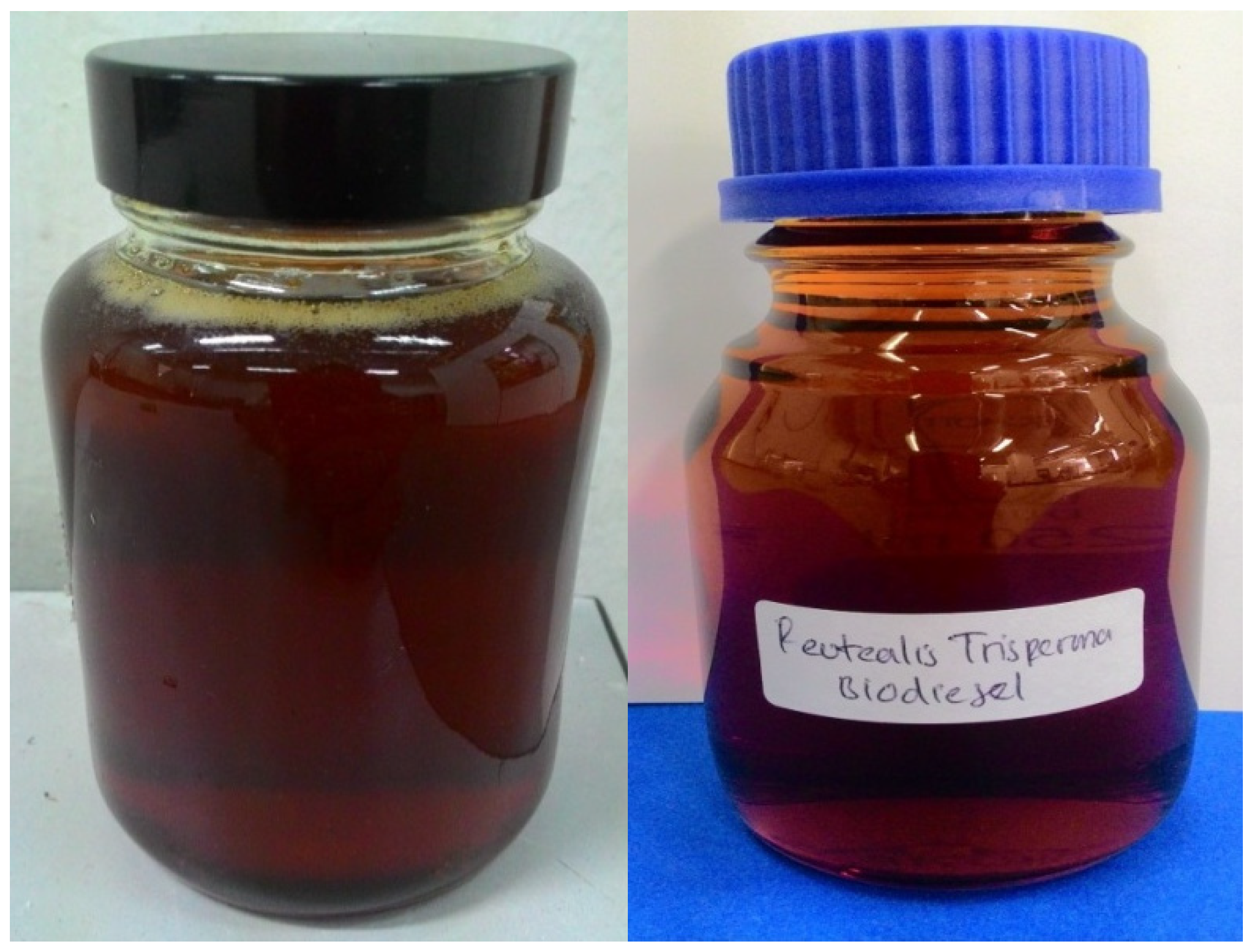
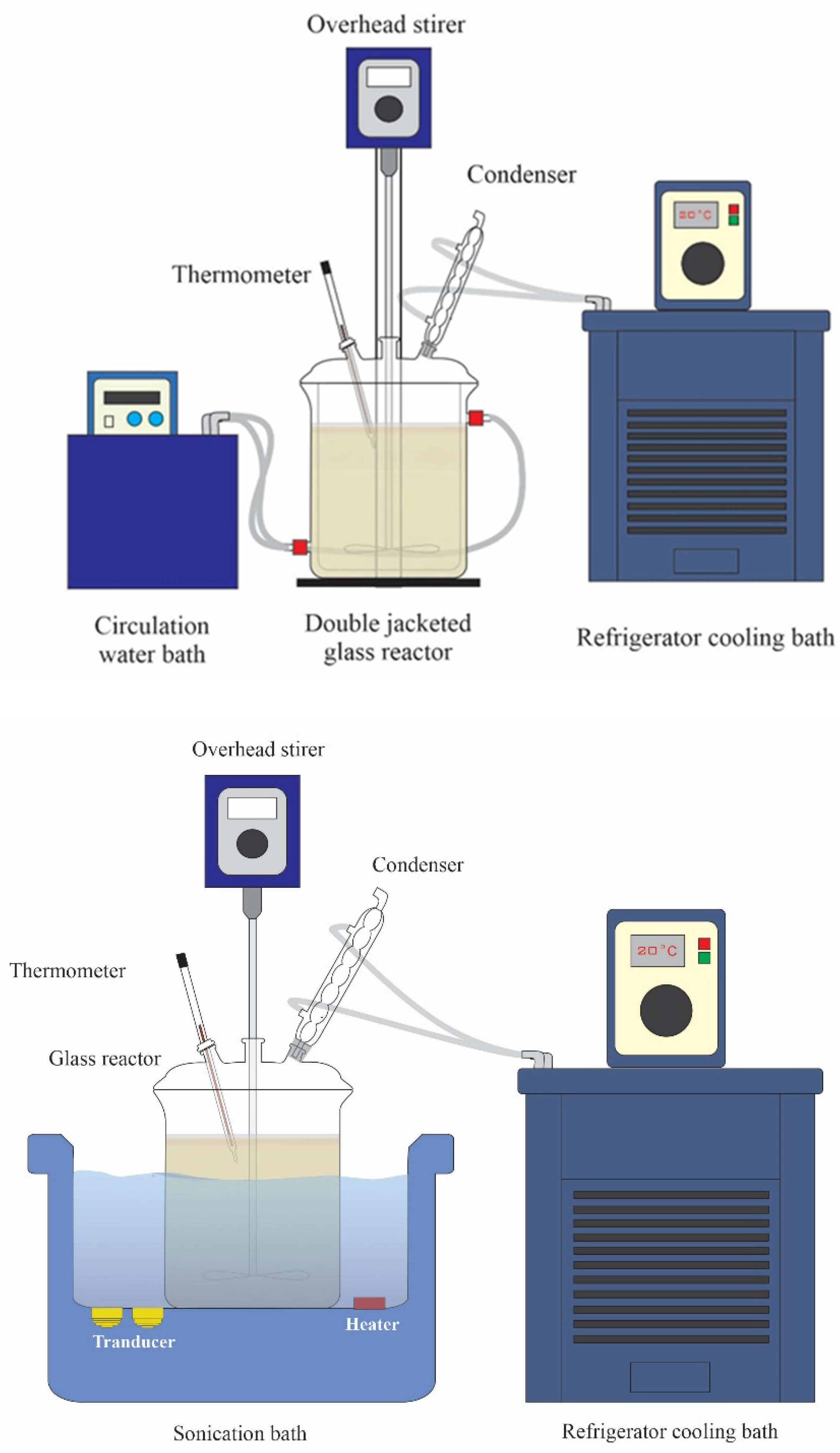
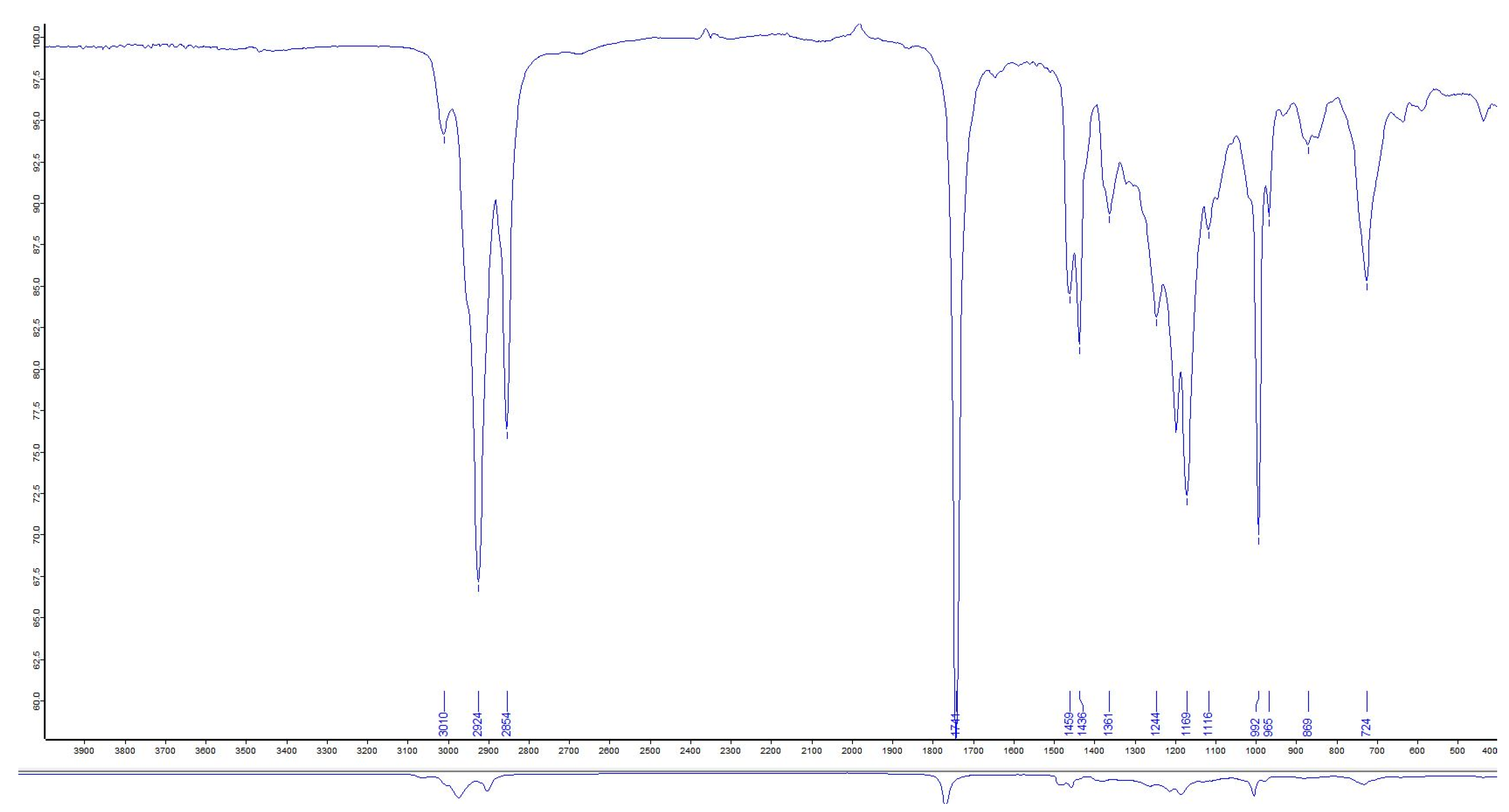
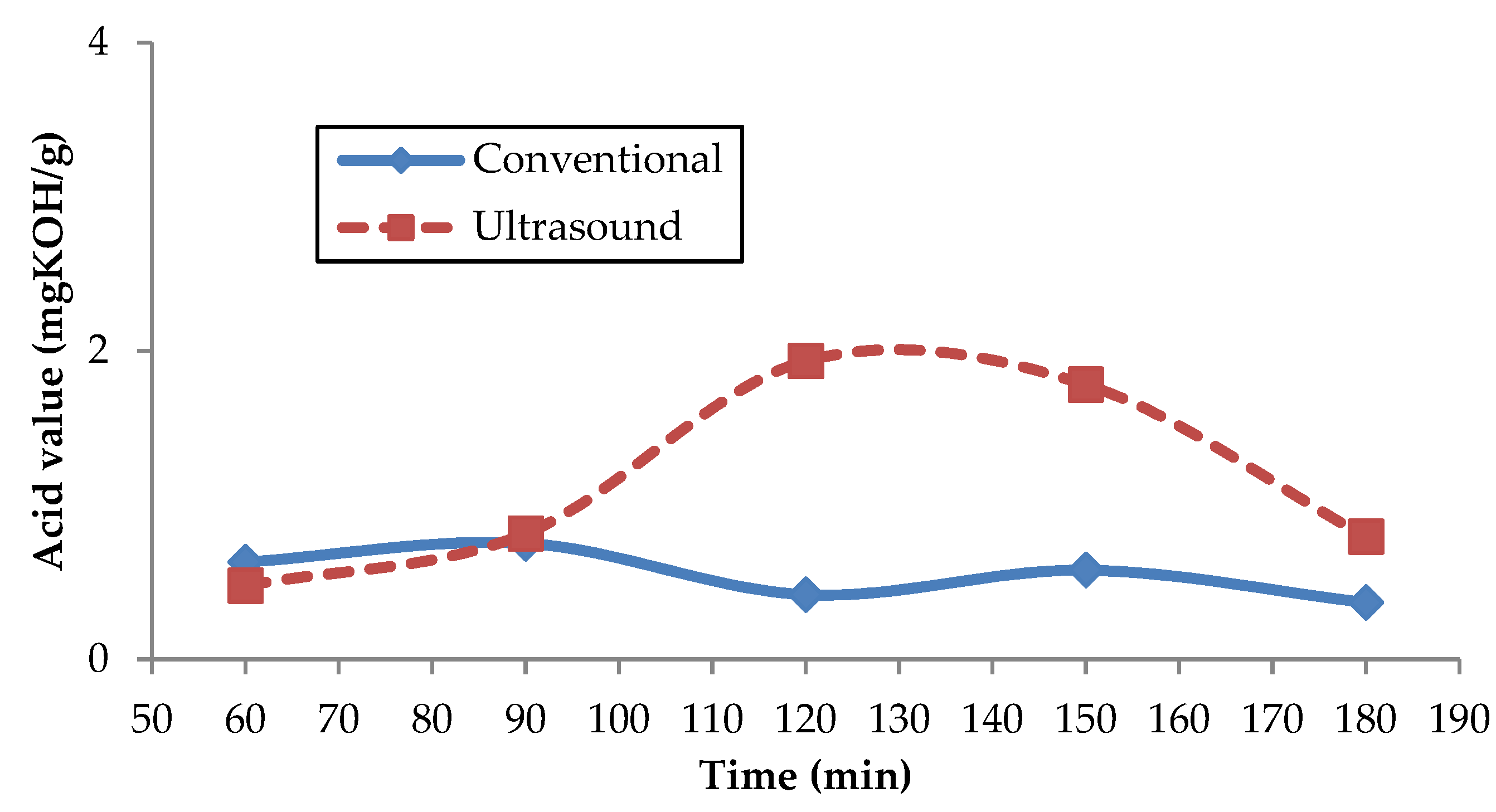
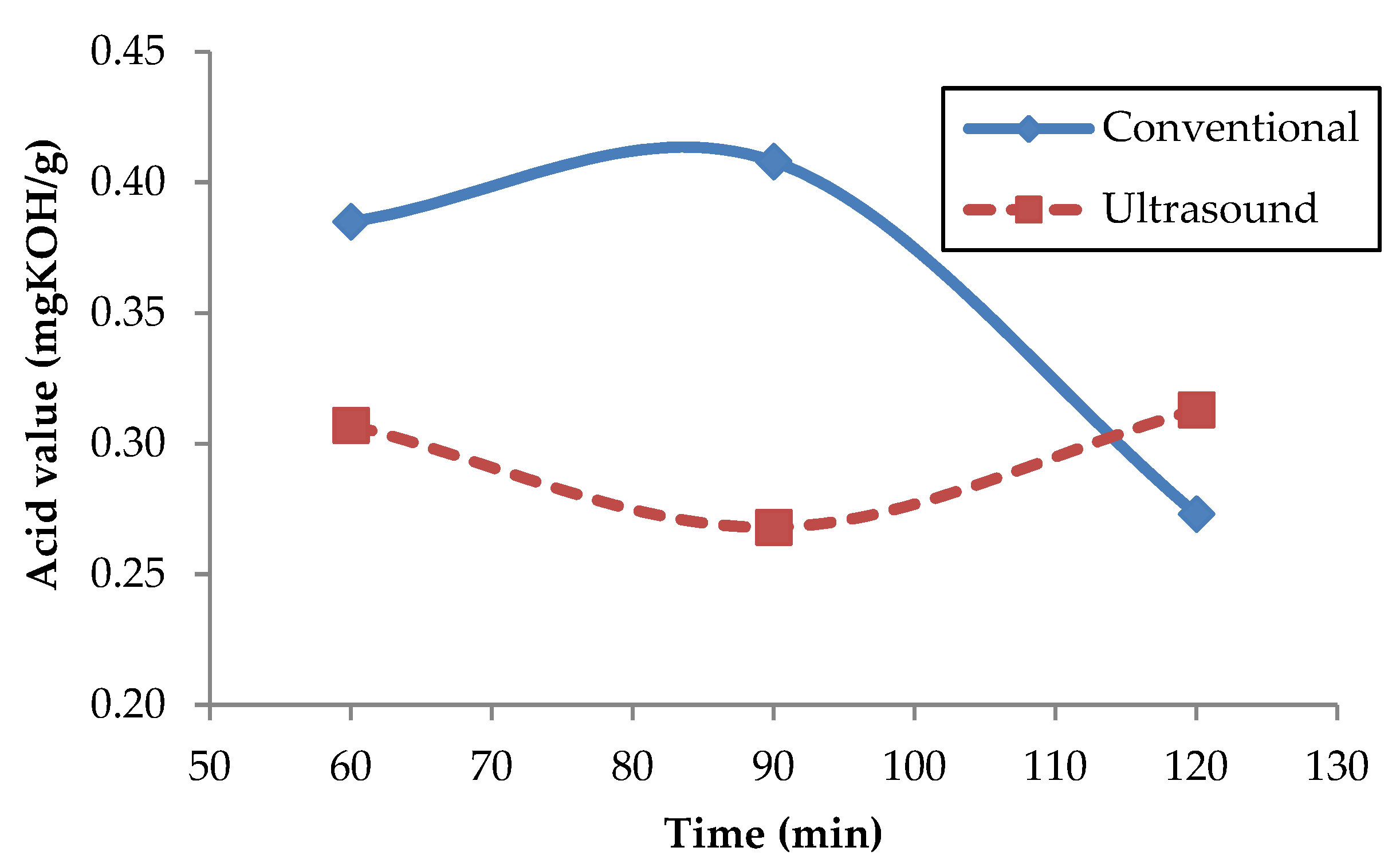
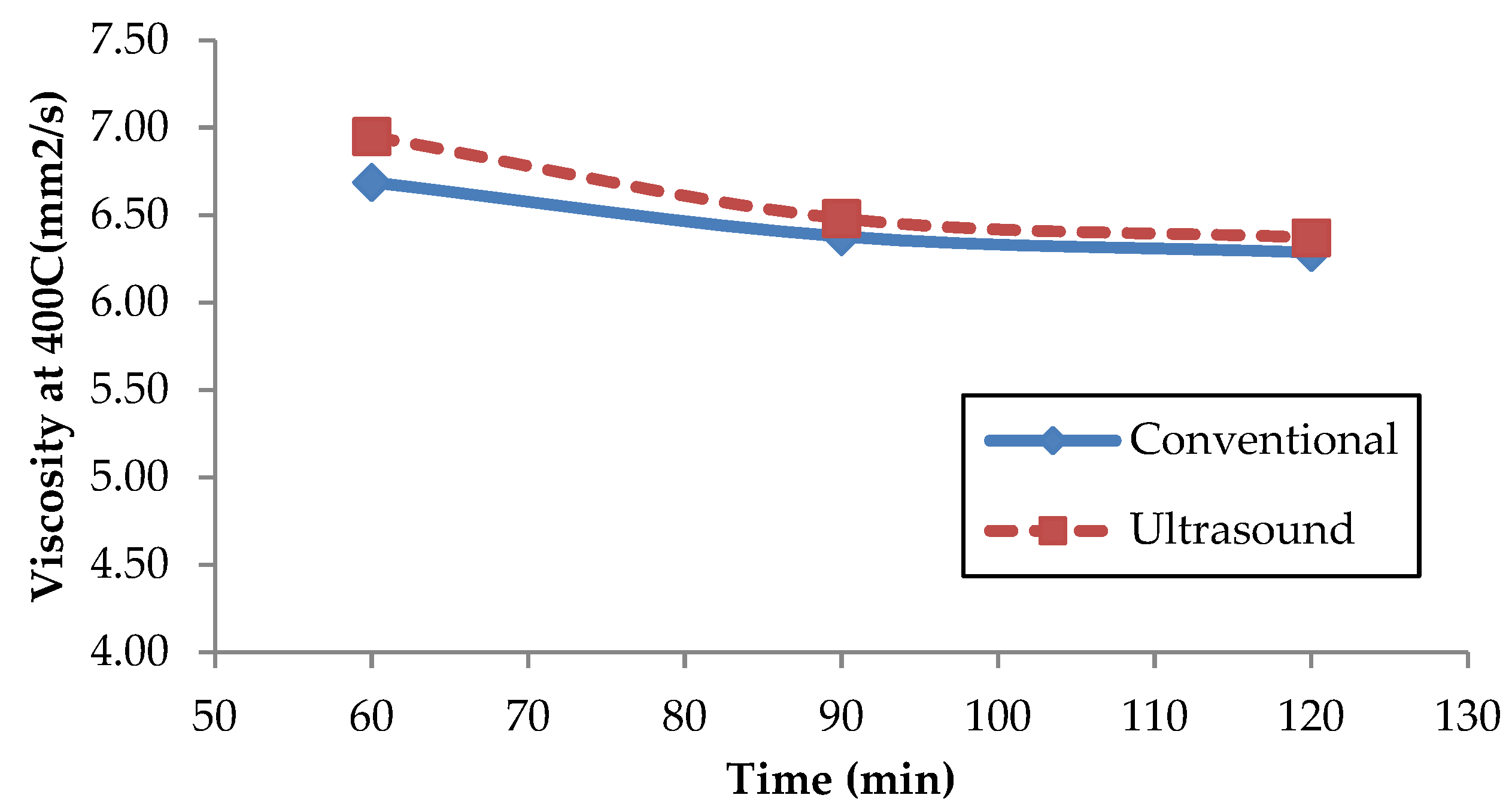
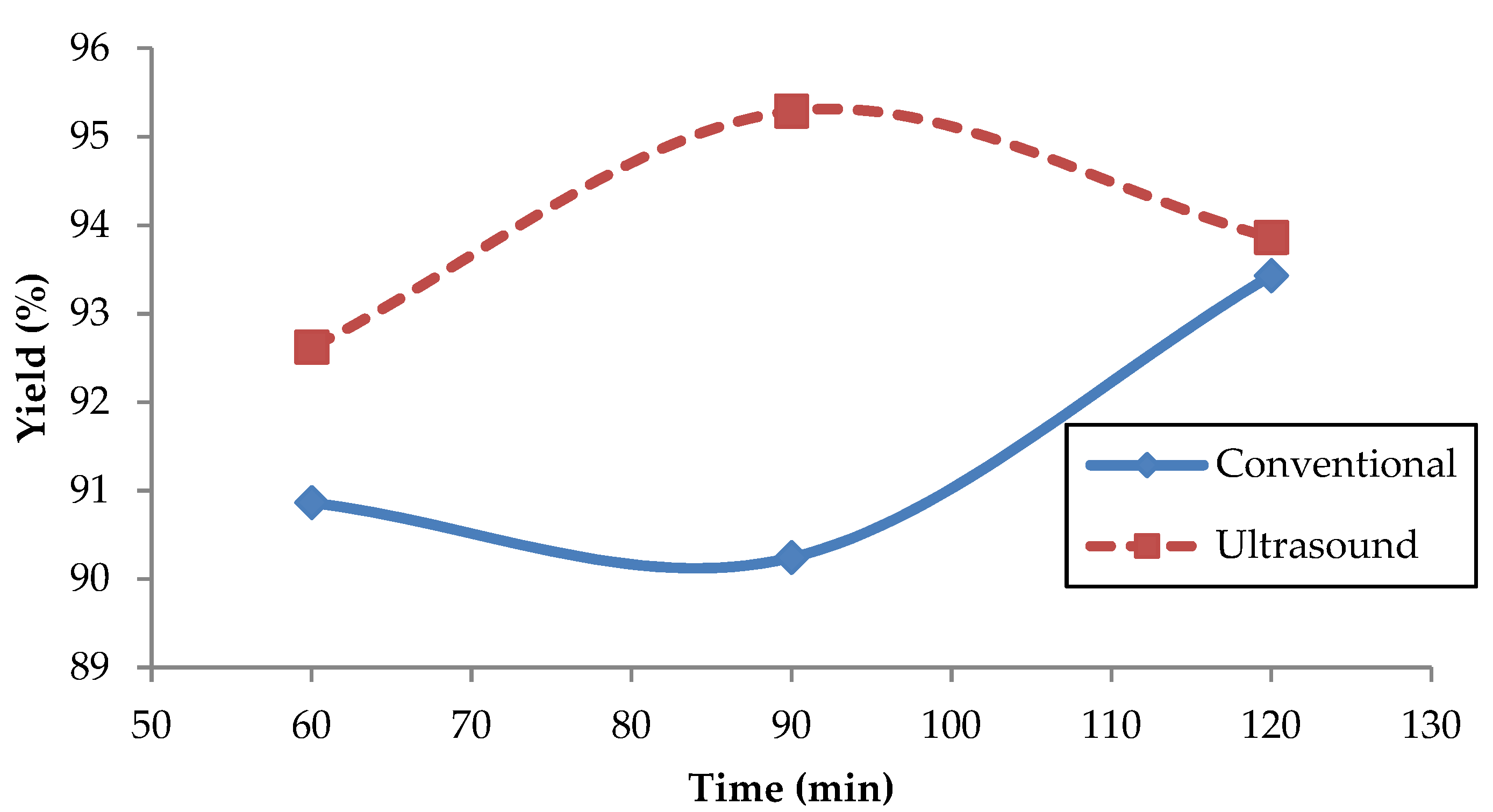
| Property | Equipment | Standard Method | Accuracy |
|---|---|---|---|
| Kinematic viscosity | NVB classic (Normalab, France) | ASTM D445 | ±0.01 mm2/s |
| Density | DM40 LiquidPhysics™ density meter (Mettler Toledo, Switzerland) | ASTM D127 | ±0.1 kg/m3 |
| Copper strip corrosion | Seta copper corrosion bath 11300-0 (StanhopeSeta, UK) | ASTM D130 | - |
| Flash point | NPM 440 Pensky-martens flash point tester (Nor, alab, France) | ASTM D93 | ±0.1 °C |
| Water content | 837 KF coulometer (Metrohm, Switzerland) | EN ISO 12937 | ±0.001% |
| Low heating value | 6100 Compensated calorimeter (Parr, USA) | ASTM D240 | ±0.001 MJ/kg |
| Cloud and pour point | NTE 450 Cloud and pour point tester (Normalab, France) | ASTM D2500 | ±0.1 °C |
| Acid value | Automation titration rondo 20 (Mettler Toledo, Switzerland) | ASTMD664 | ± 0.001 mg KOH/g |
| Sulfur content | Multi EA 5000 (Analytical jena, Germany) | ASTM D6667 | ±0.00 ppm |
| Properties | CRTO a | CCPO [53] | CSFO [53] | CCIO [54] |
|---|---|---|---|---|
| Acid value (mg KOH/g) | 44.681 | 16.80 | 0.36 | 44.0 |
| Kinematic viscosity at 40 °C (mm2/s) | 76.927 | 34.45 | 926.4 | 71.98 |
| Flash point (°C) | 236.5 | 170.5 | 158.0 | 221.0 |
| Density at 15 °C (kg/m3) | 937.0 | 905.2 | 49.7 | 896.0 |
| Fatty acid composition | wt.% | wt.% | wt.% | wt.% |
| C12:0 (lauric acid) | 0.1 | 0.1 | 0.1 | 0.1 |
| C14:0 (myristic acid) | 0.2 | 0.1 | 0.2 | 0.1 |
| C16:0 (palmitic acid) | 13.1 | 19.2 | 17.7 | 14.7 |
| C16:1 (palmitoleic acid) | 0.2 | 0.3 | 0.2 | 0.3 |
| C18:0 (stearic acid) | 5.8 | 2.6 | 4.7 | 13.2 |
| C18:1 (oleic acid) | 16.1 | 17.4 | 6.0 | 46.1 |
| C18:2 (linoleic acid) | 18.7 | 39.7 | 9.1 | 24.7 |
| C18:3 (linolenic acid) | 0.1 | 1.5 | 0.7 | 0.2 |
| C20:0 (arachidic acid) | 0.2 | 0.56 | 2.3 | 0.8 |
| C20:1 (Paullinic acid) | 0.2 | - | - | - |
| C24:0 (Lignoceric acid) | 0.1 | - | - | - |
| Wavenumber (cm−1) | Group Attribution | Vibration Type | Absorption Intensity |
|---|---|---|---|
| 3010 | =C–H | Asymmetric stretching vibration | Weak |
| 2924 | =C–H | Asymmetric stretching vibration | Strong |
| 2854 | CH2 | Symmetric stretching vibration | Strong |
| 1741 | C=O | Stretching | Strong |
| 1459 | CH2 | Shear-type vibration | Weak |
| 1244 | CH3 | Bending vibration | Weak |
| 1169 | C–O–C | Anti-symmetric stretching vibration | Middling |
| 992 | C–O–C | Anti-symmetric stretching vibration | Weak |
| 724 | CH2 | Plane rocking vibration | Weak |
| Property | Unit | ASTM D6751 Limit | EN 14214 Limit | RTME a | RTME [50] | SFME [60] | CIME [61] | CPME [53] |
|---|---|---|---|---|---|---|---|---|
| Kinematic viscosity at 40 °C | mm2/s | 1.9–6.0 | 3.5–5.0 | 6.48 | 6.71 | 3.96 | 3.45 | 4.61 |
| Density at 15 °C | kg/m3 | 880 | 860–900 | 892 | 887 | 879.1 | 877.6 | 876.9 |
| Flash point | oC | Min. 130 | Min. 120 | 206.5 | 148 | 160.5 | 165.5 | 156.5 |
| Pour point | oC | −15 to 16 | - | −2 | −15 | -3.0 | 2.0 | 2.8 |
| Cloud point | oC | −3 to 12 | - | −1 | −13 | -3.0 | 2.0 | 3.0 |
| Lower heating value | MJ/kg | – | 35 min. | 40.098 | 9208 b | 40.427 | 41.442 | 40.493 |
| Acid value | mg KOH/g | 0.5 max. | 0.5 max. | 0.26 | 0.41 | 0.14 | 0.34 | 0.38 |
| Copper corrosion strip | – | 3 max | − | 1 b | - | - | 1a | 1 |
| Water content | vol.% | 0.05 max. | 500a max. | - | - | - | 0.015 | 0.045 |
| Sulfur content (S 15 grade) | ppm | 15 max. | - | 14.85 | - | - | 6.23 | 13.97 |
| FAME content | % m/m | - | 96.5 max | - | 97.18 | - | 98.7 | 98.6 |
Publisher’s Note: MDPI stays neutral with regard to jurisdictional claims in published maps and institutional affiliations. |
© 2021 by the authors. Licensee MDPI, Basel, Switzerland. This article is an open access article distributed under the terms and conditions of the Creative Commons Attribution (CC BY) license (http://creativecommons.org/licenses/by/4.0/).
Share and Cite
Riayatsyah, T.M.I.; Thaib, R.; Silitonga, A.S.; Milano, J.; Shamsuddin, A.H.; Sebayang, A.H.; Rahmawaty; Sutrisno, J.; Mahlia, T.M.I. Biodiesel Production from Reutealis trisperma Oil Using Conventional and Ultrasonication through Esterification and Transesterification. Sustainability 2021, 13, 3350. https://doi.org/10.3390/su13063350
Riayatsyah TMI, Thaib R, Silitonga AS, Milano J, Shamsuddin AH, Sebayang AH, Rahmawaty, Sutrisno J, Mahlia TMI. Biodiesel Production from Reutealis trisperma Oil Using Conventional and Ultrasonication through Esterification and Transesterification. Sustainability. 2021; 13(6):3350. https://doi.org/10.3390/su13063350
Chicago/Turabian StyleRiayatsyah, Teuku Meurah Indra, Razali Thaib, Arridina Susan Silitonga, Jassinnee Milano, Abd. Halim Shamsuddin, Abdi Hanra Sebayang, Rahmawaty, Joko Sutrisno, and Teuku Meurah Indra Mahlia. 2021. "Biodiesel Production from Reutealis trisperma Oil Using Conventional and Ultrasonication through Esterification and Transesterification" Sustainability 13, no. 6: 3350. https://doi.org/10.3390/su13063350
APA StyleRiayatsyah, T. M. I., Thaib, R., Silitonga, A. S., Milano, J., Shamsuddin, A. H., Sebayang, A. H., Rahmawaty, Sutrisno, J., & Mahlia, T. M. I. (2021). Biodiesel Production from Reutealis trisperma Oil Using Conventional and Ultrasonication through Esterification and Transesterification. Sustainability, 13(6), 3350. https://doi.org/10.3390/su13063350








